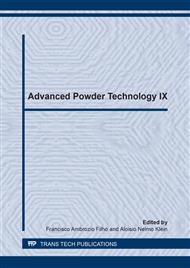p.392
p.398
p.404
p.409
p.415
p.421
p.427
p.433
p.440
Sintering Studies and Microstructural Evolution of Fe-MoS2 Mixtures
Abstract:
The development of dry self-lubricating materials is directly linked to the rising requirements of performance. Iron and steel are the most used metals around the world and molybdenum disulfide (MoS2) one of the most used solid lubricant. Therefore it is expected that one might try to develop self-lubricating steels containing MoS2, however MoS2 reacts with steel matrices during sintering. This work has focused on the study of these reactions; temperatures at which this occurs; the influence of particle sizes and MoS2 content and also MoS2 influence during processing and in the parts properties. The results showed that the reaction occurs at lower temperatures than the predicted and the products are iron-molybdenum and iron sulfides. The sintering studies revealed that MoS2 enhances sintering and the particle size and MoS2 content directly influenced the morphology and chemical composition of the resulting phases.
Info:
Periodical:
Pages:
415-420
Citation:
Online since:
December 2014
Keywords:
Price:
Сopyright:
© 2014 Trans Tech Publications Ltd. All Rights Reserved
Share:
Citation:


